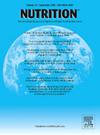Food insecurity is associated with obesity and abdominal obesity among older adults: A cross-sectional analysis of ELSA study
IF 3.2
3区 医学
Q2 NUTRITION & DIETETICS
引用次数: 0
Abstract
Objectives
Food insecurity, defined as limited or uncertain access to adequate and nutritious food, is a significant public health issue, particularly among older adults. While often associated with undernutrition, food insecurity has also been linked to overweight and obesity due to economic constraints that drive reliance on inexpensive, energy-dense foods in younger people. The aim of this study was to assess the association between food insecurity and measures of adiposity, including body mass index (BMI), waist circumference, and waist-hip ratio, in older adults.
Methods
This cross-sectional study utilized data from wave 2 of the English Longitudinal Study of Ageing – ELSA (2004–2005), including adults aged ≥50 years. Food insecurity was assessed through a single-question measure. Multivariable logistic regression models were used to examine the association between food insecurity and obesity-related outcomes, adjusting for potential confounders, and reporting the data as odds ratios (ORs) with their 95% confidence intervals (CIs).
Results
Of 7219 participants, with a mean age of 66 years and mainly females (53.6%), 1.3% reported food insecurity, whilst obesity, according to BMI, was present in 28.9%. After adjusting for several potential confounders, food-insecure individuals had higher odds of obesity (OR = 1.55, 95% CI: 1.03–2.32, P = 0.034) and abdominal obesity (OR = 2.28, 95% CI: 1.45–3.60, P < 0.001). No association was found with the waist-hip ratio (P = 0.117).
Conclusions
Food insecurity is significantly associated with obesity and central adiposity in older adults, highlighting the need for public health interventions addressing both food access and dietary quality. Further research should evaluate the long-term impact of food insecurity on metabolic health in aging populations.

食品不安全与老年人肥胖和腹部肥胖相关:ELSA研究的横断面分析
粮食不安全的定义是获得充足和有营养的食物的机会有限或不确定,这是一个重大的公共卫生问题,特别是在老年人中。粮食不安全通常与营养不良有关,但也与超重和肥胖有关,因为经济限制促使年轻人依赖廉价、高能量的食物。本研究的目的是评估老年人食品不安全与肥胖指标之间的关系,包括体重指数(BMI)、腰围和腰臀比。方法本横断面研究采用了英国老龄化纵向研究ELSA(2004-2005)第二波的数据,包括年龄≥50岁的成年人。粮食不安全是通过一个单一的问题来评估的。使用多变量逻辑回归模型来检验食品不安全和肥胖相关结果之间的关系,调整潜在混杂因素,并以比值比(or)及其95%置信区间(ci)报告数据。结果在7219名参与者中,平均年龄为66岁,主要是女性(53.6%),1.3%的人报告食物不安全,而根据BMI, 28.9%的人存在肥胖。在调整了几个潜在的混杂因素后,食物不安全个体肥胖(OR = 1.55, 95% CI: 1.03-2.32, P = 0.034)和腹部肥胖(OR = 2.28, 95% CI: 1.45-3.60, P <;0.001)。与腰臀比无相关性(P = 0.117)。结论:粮食不安全与老年人肥胖和中心性肥胖显著相关,这凸显了对食物获取和饮食质量进行公共卫生干预的必要性。进一步的研究应评估粮食不安全对老年人代谢健康的长期影响。
本文章由计算机程序翻译,如有差异,请以英文原文为准。
求助全文
约1分钟内获得全文
求助全文
来源期刊

Nutrition
医学-营养学
CiteScore
7.80
自引率
2.30%
发文量
300
审稿时长
60 days
期刊介绍:
Nutrition has an open access mirror journal Nutrition: X, sharing the same aims and scope, editorial team, submission system and rigorous peer review.
Founded by Michael M. Meguid in the early 1980''s, Nutrition presents advances in nutrition research and science, informs its readers on new and advancing technologies and data in clinical nutrition practice, encourages the application of outcomes research and meta-analyses to problems in patient-related nutrition; and seeks to help clarify and set the research, policy and practice agenda for nutrition science to enhance human well-being in the years ahead.
 求助内容:
求助内容: 应助结果提醒方式:
应助结果提醒方式:


